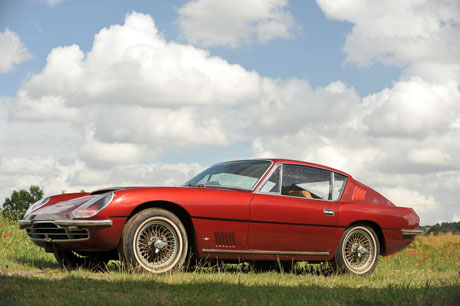SCM Analysis
Detailing
| Vehicle: | 1966 Aston Martin DBSC |
| Years Produced: | 1966 |
| Number Produced: | 2 |
| Tune Up Cost: | $900 |
| Distributor Caps: | $83 |
| Chassis Number Location: | Plate riveted to left side of scuttle |
| Engine Number Location: | Stamped on right side of engine block |
| Website: | http://www.amoc.org |
| Alternatives: | 1966 Lamborghini Flying Star II, 1962 Ferrari 250 GT Drogo, 1962 Maserati 5000 GT Frua coupe |
| Investment Grade: | B |
This 1966 Aston Martin DBSC Coupe sold for $522,415, including buyer’s premium, at the Bonhams Goodwood Revival auction in Chichester, Sussex, England, on September 18, 2009.
Let’s not be blinded by the price tag here. The Italians never improved on Jaguar or Aston designs, with the exception of Zagato’s DB4GT. This is one of two prototypes built, before the factory shelved the project in order to concentrate its limited resources on developing the four-seater DBS.
As Bonhams said: “Any special coachbuilt motorcar is rightly regarded as highly coveted and desirable. It is even more so when connected to one of the most famous marques in the history of the motor car industry.” But let’s not run away with ourselves here. When new, it cost £8,900(about $29,000)-considerably more than a Rolls-Royce Silver Shadow, and the owner had to sell six other cars to finance it.
In a more attractive color than its sister, which is currently painted in a dowdy shade of maroon, this Aston Martin DBSC Coupe exuded a certain charm, from the Mazda Cosmo-like front end to the Virgil Exner-style taillamps. But a cocktail of ’60s design cues does not automatically improve on the original-in this case, a cohesive, elegant coupe designed by William Towns (with a nod to the first Camaro, as Towns admitted-park them together, and in profile they’re creepily similar).
Not much more than the dust blown off
As viewed at the sale, it was not long out of storage, with not much more than the dust blown off and was therefore unmolested, apart from time and the atmosphere, and was still largely as it had been put away almost four decades before. That storage must have been careful-or just lucky-because it was in much better shape than your regular barn find. The paint was mostly still on the car, just peeling a little at the edges, no serious corrosion was apparent, and the interior was un-mildewed. It looked as though you could have clipped a battery to it, fired up the straight-6 and driven it home. As is usually the case with notable, or “cherished” registration numbers, the one attached to this DBSC Coupe was retained by the vendor, though this makes no difference here, as the car left the U.K.-the big money is abroad right now.
Now, the big issue: This Coupe fetched about ten times the price of probably the best DBS on the planet. Why? Partly because it’s a real coachbuilt rarity and partly because the market’s not quite in its right mind at the moment. Another Aston, also unmolested and with long-term ownership, but this time the most historic example of a most popular and sought-after model, the DB2-and with cast-iron Le Mans class-winning history-brought only $388k more when it sold at RM London the following month. And that’s for a certified piece of motoring history.
As Dan Aykroyd’s Elwood said in “The Blues Brothers” of the Cadillac/microphone trade: “I can see that.” What I can’t see is this much money for an ugly duckling hiding an unloved engine/chassis combination. Dynamically, this might have been an improvement on the original, but I doubt this was really much lighter than the Newport Pagnell offering. And there is a tenuous Twiggy connection-she was supposed to have test-driven it-but not firm enough to make a difference here. Its perceived value must come from the fact that there are only two of them, and one of those isn’t for sale, the left-handed 2662L being tied up in long-term ownership. I’d call this extremely well sold; however, it must be said that if you think it’s too expensive, go find another.
